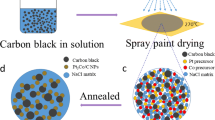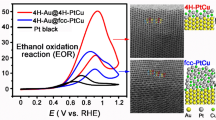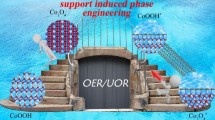Abstract
Large-scale production of unconventional phase-controlled telluride catalysts in a simple and fast manner still poses a great challenge. Herein, we develop a superfast tellurizing synthesis method that can quickly prepare unconventional phase-controlled palladium telluride nanoparticles (Pd-Te NPs) on carbon nanotubes (CNTs) (i.e., PdTe/CNT, Pd20Te7/CNT) in 60 s. By merely tuning the mass of the tellurium precursors under the same conditions, fine (about 5.5 nm) and high-yield (about 90%) hexagonal structured PdTe/CNT and rhombohedral structured Pd20Te7/CNT can be precisely synthesized. The hexagonal structured PdTe/CNT exhibits excellent performance for glycerol oxidation reaction (GOR) and ethylene glycol oxidation reaction (EGOR). Specifically, the highest current density for GOR is 2.72 A mgPd−1, which is 1.9-fold higher than that of rhombohedral structured Pd20Te7/CNT, and 2.8-fold higher than that of Pd/CNT. It also outperforms most catalysts reported in GOR. Meanwhile, the specific activity for EGOR is 3.65 A mgPd−1, which is 2.1 and 3.9 times higher than those of rhombohedral structured Pd20Te7/CNT and Pd/CNT. We hope that this work can provide guidance for the preparation of crystalline phase-controlled telluride catalysts via new tellurization and inspire the application of crystalline phase-controlled materials.

摘要
本研究发展了一种超快的碲化方法, 可以在碳纳米管上快速制备非常规相控碲化钯小纳米颗粒. 这种碲化方法只需要一台家用微波炉, 整个过程非常快(60秒), 简单, 不含表面活性剂, 可规模化生产. 通过在相同条件下仅调整前驱体Te粉的使用量, 可以精确调控合成小尺寸(约5.5 nm)、 高产率(约90%)的六方结构PdTe/CNT和菱方结构Pd20Te7/CNT. 其中, 六方结构的PdTe/CNT在甘油氧化反应(GOR)和乙二醇氧化反应(EGOR)中表现出卓越的性能. 具体来说, 六方结构的PdTe/CNT在甘油氧化反应中, 最高电流密度可达2.72 A mgPd−1, 比菱方结构Pd20Te7/CNT的最高电流密度高1.9倍, 比Pd/CNT最高电流密度高2.8倍, 超过了目前文献中报道过的大多数催化剂. 同时, 六方结构的PdTe/CNT在乙二醇氧化反应中比活性达到3.65 A mgPd−1, 比菱方结构的Pd20Te7/CNT和Pd/CNT分别高2.1倍和3.9倍. 我们希望这项工作可以为小尺寸非常规相控碲化物催化剂的制备提供新的碲化方法指导, 并为相控材料的应用提供启发.
Similar content being viewed by others
References
Pedireddy S, Lee HK, Tjiu WW, et al. One-step synthesis of zero-dimensional hollow nanoporous gold nanoparticles with enhanced methanol electrooxidation performance. Nat Commun, 2014, 5: 4947
Tian N, Zhou ZY, Sun SG, et al. Synthesis of tetrahexahedral platinum nanocrystals with high-index facets and high electro-oxidation activity. Science, 2007, 316: 732–735
Li C, Yuan Q, Ni B, et al. Dendritic defect-rich palladium-copper-cobalt nanoalloys as robust multifunctional non-platinum electrocatalysts for fuel cells. Nat Commun, 2018, 9: 3702
Huang H, Yang S, Vajtai R, et al. Pt-decorated 3D architectures built from graphene and graphitic carbon nitride nanosheets as efficient methanol oxidation catalysts. Adv Mater, 2014, 26: 5160–5165
Xu C, Wang H, Shen P, et al. Highly ordered Pd nanowire arrays as effective electrocatalysts for ethanol oxidation in direct alcohol fuel cells. Adv Mater, 2007, 19: 4256–4259
Gao F, Zhang Y, Song P, et al. Precursor-mediated size tuning of monodisperse PtRh nanocubes as efficient electrocatalysts for ethylene glycol oxidation. J Mater Chem A, 2019, 7: 7891–7896
** H, Li L, Liu X, et al. Nitrogen vacancies on 2D layered W2N3: A stable and efficient active site for nitrogen reduction reaction. Adv Mater, 2019, 31: 1902709
Chen L, Lu L, Zhu H, et al. Improved ethanol electrooxidation performance by shortening Pd-Ni active site distance in Pd-N-P nanocatalysts. Nat Commun, 2017, 8: 14136
Li H, Han Y, Zhao H, et al. Fast site-to-site electron transfer of high-entropy alloy nanocatalyst driving redox electrocatalysis. Nat Commun, 2020, 11: 5437
Lu Y, Wang W, Chen X, et al. Composition optimized trimetallic PtNiRu dendritic nanostructures as versatile and active electrocatalysts for alcohol oxidation. Nano Res, 2019, 12: 651–657
Geng SK, Zheng Y, Li SQ, et al. Nickel ferrocyanide as a high-performance urea oxidation electrocatalyst. Nat Energy, 2021, 6: 904–912
Kim HJ, Ahn YD, Kim J, et al. Surface elemental distribution effect of Pt-Pb hexagonal nanoplates for electrocatalytic methanol oxidation reaction. Chin J Catal, 2020, 41: 813–819
Yang F, Ye JY, Yuan Q, et al. Ultrasmall Pd-Cu-Pt trimetallic twin icosahedrons boost the electrocatalytic performance of glycerol oxidation at the operating temperature of fuel cells. Adv Funct Mater, 2020, 30: 1908235
Ma J, Mao K, Low J, et al. Efficient photoelectrochemical conversion of methane into ethylene glycol by WO3 nanobar arrays. Angew Chem Int Ed, 2021, 60: 9357–9361
Chen Z, Liu C, Zhao X, et al. Promoted glycerol oxidation reaction in an interface-confined hierarchically structured catalyst. Adv Mater, 2019, 31: 1804763
Munoz F, Hua C, Kwong T, et al. Palladium-copper electrocatalyst for the promotion of the electrochemical oxidation of polyalcohol fuels in the alkaline direct alcohol fuel cell. Appl Catal B-Environ, 2015, 174–175: 323–328
Li S, Tian ZQ, Liu Y, et al. Hierarchically skeletal multi-layered Pt-Ni nanocrystals for highly efficient oxygen reduction and methanol oxidation reactions. Chin J Catal, 2021, 42: 648–657
Mougenot M, Caillard A, Simoes M, et al. PdAu/C catalysts prepared by plasma sputtering for the electro-oxidation of glycerol. Appl Catal B-Environ, 2011, 107: 372–379
Hong W, Shang C, Wang J, et al. Bimetallic PdPt nanowire networks with enhanced electrocatalytic activity for ethylene glycol and glycerol oxidation. Energy Environ Sci, 2015, 8: 2910–2915
de Souza MBC, Vicente RA, Yukuhiro VY, et al. Bi-modified Pt electrodes toward glycerol electrooxidation in alkaline solution: Effects on activity and selectivity. ACS Catal, 2019, 9: 5104–5110
Yang X, Yao K, Ye JY, et al. Interface-rich three-dimensional Au-doped PtBi intermetallics as highly effective anode catalysts for application in alkaline ethylene glycol fuel cells. Adv Funct Mater, 2021, 31: 2103671
Du H, Wang K, Tsiakaras P, et al. Excavated and dendritic Pt-Co nanocubes as efficient ethylene glycol and glycerol oxidation electrocatalysts. Appl Catal B-Environ, 2019, 258: 117951
Li H, Pan Y, Zhang D, et al. Surface oxygen-mediated ultrathin PtRuM (Ni, Fe, and Co) nanowires boosting methanol oxidation reaction. J Mater Chem A, 2020, 8: 2323–2330
Ma XY, Chen Y, Wang H, et al. Electrocatalytic oxidation of ethanol and ethylene glycol on cubic, octahedral and rhombic dodecahedral palladium nanocrystals. Chem Commun, 2018, 54: 2562–2565
Li S, Lai J, Luque R, et al. Designed multimetallic Pd nanosponges with enhanced electrocatalytic activity for ethylene glycol and glycerol oxidation. Energy Environ Sci, 2016, 9: 3097–3102
Qiao B, Yang T, Shi S, et al. Highly active hollow RhCu nanoboxes toward ethylene glycol electrooxidation. Small, 2021, 17: 2006534
** L, Xu H, Chen C, et al. Superior ethanol oxidation electrocatalysis enabled by ternary Pd-Rh-Te nanotubes. Inorg Chem, 2019, 58: 12377–12384
Qiao W, Yang X, Li M, et al. Hollow Pd/Te nanorods for the effective electrooxidation of methanol. Nanoscale, 2021, 13: 6884–6889
He Y, Yan D, Wang S, et al. Topological type-II Dirac semimetal and superconductor PdTe2 for ethanol electrooxidation. Energy Technol, 2019, 7: 1900663
Yuan M, Li Q, Zhang J, et al. Engineering surface atomic architecture of NiTe nanocrystals toward efficient electrochemical N2 fixation. Adv Funct Mater, 2020, 30: 2004208
Li HH, Zhao S, Gong M, et al. Ultrathin PtPdTe nanowires as superior catalysts for methanol electrooxidation. Angew Chem Int Ed, 2013, 52: 7472–7476
Wang H, Yin S, Li C, et al. Direct synthesis of superlong Pt∣Te mesoporous nanotubes for electrocatalytic oxygen reduction. J Mater Chem A, 2019, 7: 1711–1717
Wang J, Han L, Huang B, et al. Amorphization activated ruthenium-tellurium nanorods for efficient water splitting. Nat Commun, 2019, 10: 5692
Zhao F, Zheng L, Yuan Q, et al. Ultrathin PdAuBiTe nanosheets as high-performance oxygen reduction catalysts for a direct methanol fuel cell device. Adv Mater, 2021, 33: 2103383
Arora A, Oswal P, Rao GK, et al. Catalytically active nanosized Pd9Te4 (telluropalladinite) and PdTe (kotulskite) alloys: First precursor-architecture controlled synthesis using palladium complexes of organotellurium compounds as single source precursors. RSC Adv, 2021, 11: 7214–7224
Fan Z, Zhang H. Crystal phase-controlled synthesis, properties and applications of noble metal nanomaterials. Chem Soc Rev, 2016, 45: 63–82
Chen Q, Cheng T, Fu H, et al. Crystal phase regulation in noble metal nanocrystals. Chin J Catal, 2019, 40: 1035–1056
Yang Z, Zhao T, Huang X, et al. Modulating the phases of iron carbide nanoparticles: From a perspective of interfering with the carbon penetration of Fe@Fe3O4 by selectively adsorbed halide ions. Chem Sci, 2017, 8: 473–481
Ding J, Bu L, Guo S, et al. Morphology and phase controlled construction of Pt-Ni nanostructures for efficient electrocatalysis. Nano Lett, 2016, 16: 2762–2767
Wang J, Zhang J, Liu G, et al. Crystal phase-controlled growth of PtCu and PtCo alloys on 4H Au nanoribbons for electrocatalytic ethanol oxidation reaction. Nano Res, 2020, 13: 1970–1975
Ge Y, Huang Z, Ling C, et al. Phase-selective epitaxial growth of heterophase nanostructures on unconventional 2H-Pd nanoparticles. J Am Chem Soc, 2020, 142: 18971–18980
Tong W, Huang B, Wang P, et al. Crystal-phase-engineered PdCu electrocatalyst for enhanced ammonia synthesis. Angew Chem Int Ed, 2020, 59: 2649–2653
Wang X, Zhuang L, Jia Y, et al. Plasma-triggered synergy of exfoliation, phase transformation, and surface engineering in cobalt diselenide for enhanced water oxidation. Angew Chem Int Ed, 2018, 57: 16421–16425
Ma Z, Yu J, Dai S. Preparation of inorganic materials using ionic liquids. Adv Mater, 2010, 22: 261–285
Liu L, Wu J, Wu L, et al. Phase-selective synthesis of 1T′ MoS2 monolayers and heterophase bilayers. Nat Mater, 2018, 17: 1108–1114
Yu Z, Xu S, Feng Y, et al. Phase-controlled synthesis of Pd-Se nanocrystals for phase-dependent oxygen reduction catalysis. Nano Lett, 2021, 21: 3805–3812
Han HS, Choi H, Mhin S, et al. Advantageous crystalline-amorphous phase boundary for enhanced electrochemical water oxidation. Energy Environ Sci, 2019, 12: 2443–2454
Wang J, Ji Y, Shao Q, et al. Phase and structure modulating of bimetallic CuSn nanowires boosts electrocatalytic conversion of CO2. Nano Energy, 2019, 59: 138–145
Piao JY, Gu L, Wei Z, et al. Phase control on surface for the stabilization of high energy cathode materials of lithium ion batteries. J Am Chem Soc, 2019, 141: 4900–4907
Li H, Wang X. Phase control in inorganic nanocrystals through finely tuned growth at an ultrathin scale. Acc Chem Res, 2019, 52: 780–790
Han X, Yu C, Huang H, et al. Phase controllable synthesis of Ni2+ post-modified CoP nanowire for enhanced oxygen evolution. Nano Energy, 2019, 62: 136–143
Huang W, Ma XY, Wang H, et al. Promoting effect of Ni(OH)2 on palladium nanocrystals leads to greatly improved operation durability for electrocatalytic ethanol oxidation in alkaline solution. Adv Mater, 2017, 29: 1703057
Li X, Fang Y, Wang J, et al. Ordered clustering of single atomic Te vacancies in atomically thin PtTe2 promotes hydrogen evolution catalysis. Nat Commun, 2021, 12: 2351
Cai J, Huang Y, Guo Y. PdTex/C nanocatalysts with high catalytic activity for ethanol electro-oxidation in alkaline medium. Appl Catal B-Environ, 2014, 150–151: 230–237
Singh RN, Singh A, Anindita A. Electrocatalytic activity of binary and ternary composite films of Pd, MWCNT and Ni, Part II: Methanol electrooxidation in 1 M KOH. Int J Hydrogen Energy, 2009, 34: 2052–2057
Acknowledgements
This work was supported by the National Natural Science Foundation of China (51772162, 22001143, and 52072197), the Youth Innovation and Technology Foundation of Shandong Higher Education Institutions, China (2019KJC004), the Outstanding Youth Foundation of Shandong Province, China (ZR2019JQ14), Taishan Scholar Young Talent Program (tsqn201909114 and tsqn201909123), the Natural Science Foundation of Shandong Province (ZR2020YQ34), the Major Scientific and Technological Innovation Project (2019JZZY020405), and the Major Basic Research Program of Natural Science Foundation of Shandong Province (ZR2020ZD09).
Author information
Authors and Affiliations
Contributions
Author contributions Han Y performed the experiments, analyzed the data and wrote the manuscript. Zhang Y and Zhang X performed partial experiments and offered helpful suggestions. Sun Y and Cai W analyzed the data and offered helpful suggestions. Li Z contributed to the software and sources. Lai J contributed to the analysis, supervision and editing. Wang L contributed to the supervision and editing. All authors contributed to the general discussion.
Corresponding authors
Ethics declarations
Conflict of interest The authors declare that they have no conflict of interest.
Additional information
Yi Han is a PhD student at Qingdao University of Science and Technology. Her research mainly focuses on the design and synthesis of nanomaterials and their electrocatalytic applications.
Jian** Lai received his PhD degree from Changchun Institute of Applied Chemistry, Chinese Academy of Sciences in 2017, and then he worked as a postdoctoral scholar at Peking University (2017–2019). In 2019, he joined Qingdao University of Science and Technology as a professor. His current research interests focus on clean energy electrocatalytic materials.
Lei Wang obtained his PhD degree in inorganic chemistry from Jilin University in 2006. He is now a professor in inorganic chemistry at the College of Chemistry and Molecular Engineering, Qingdao University of Science and Technology. The current research of his group focuses on the synthesis of nanosized functional materials for applications in photocatalysis, electrocatalysis, and batteries.
Supplementary information Supporting data are available in the online version of the paper.
Rights and permissions
About this article
Cite this article
Han, Y., Zhang, Y., Zhang, X. et al. Superfast tellurizing synthesis of unconventional phase-controlled small Pd-Te nanoparticles. Sci. China Mater. 65, 1853–1860 (2022). https://doi.org/10.1007/s40843-021-1952-4
Received:
Accepted:
Published:
Issue Date:
DOI: https://doi.org/10.1007/s40843-021-1952-4




